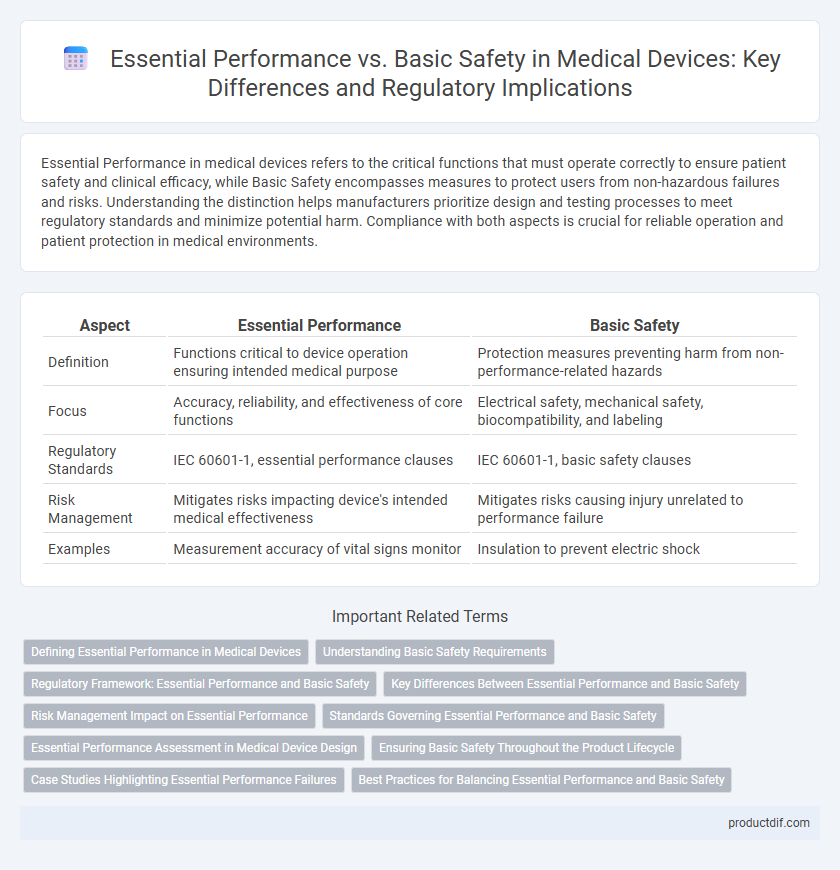Essential Performance in medical devices refers to the critical functions that must operate correctly to ensure patient safety and clinical efficacy, while Basic Safety encompasses measures to protect users from non-hazardous failures and risks. Understanding the distinction helps manufacturers prioritize design and testing processes to meet regulatory standards and minimize potential harm. Compliance with both aspects is crucial for reliable operation and patient protection in medical environments.
Table of Comparison
| Aspect | Essential Performance | Basic Safety |
|---|---|---|
| Definition | Functions critical to device operation ensuring intended medical purpose | Protection measures preventing harm from non-performance-related hazards |
| Focus | Accuracy, reliability, and effectiveness of core functions | Electrical safety, mechanical safety, biocompatibility, and labeling |
| Regulatory Standards | IEC 60601-1, essential performance clauses | IEC 60601-1, basic safety clauses |
| Risk Management | Mitigates risks impacting device's intended medical effectiveness | Mitigates risks causing injury unrelated to performance failure |
| Examples | Measurement accuracy of vital signs monitor | Insulation to prevent electric shock |
Defining Essential Performance in Medical Devices
Essential Performance in medical devices refers to the specific functions that are crucial to ensuring the device operates safely and effectively under normal conditions and foreseeable misuse. These functions directly impact the protection of patients, users, and others from unacceptable risks, aligning with regulatory standards such as ISO 14971 and IEC 60601. Defining Essential Performance requires a thorough risk assessment to distinguish critical features that, if compromised, could lead to hazardous situations or device failure.
Understanding Basic Safety Requirements
Basic Safety in medical devices ensures protection against hazards that could cause physical harm or health deterioration during normal use, prioritizing patient and user safety. Essential Performance, however, refers to device functions necessary to achieve intended clinical benefits without compromising Basic Safety. Understanding Basic Safety requirements is critical for compliance with regulatory standards such as IEC 60601-1, which mandates risk management processes to address potential electrical, mechanical, and environmental risks in medical device design.
Regulatory Framework: Essential Performance and Basic Safety
Essential Performance and Basic Safety are key components defined in the regulatory framework governing medical devices, ensuring devices operate as intended without causing undue risk. Essential Performance refers to the functions critical to the intended clinical purpose that must consistently deliver accurate and reliable results, while Basic Safety encompasses the device's protection against hazards such as electrical, mechanical, and biological risks. Compliance with standards like IEC 60601 establishes criteria for evaluating both Essential Performance and Basic Safety to meet regulatory requirements and safeguard patient and user health.
Key Differences Between Essential Performance and Basic Safety
Essential Performance in medical devices refers to the functions required to achieve the intended purpose without unacceptable risk, directly impacting patient outcomes and device reliability. Basic Safety encompasses requirements that prevent harm to patients and users, such as electrical safety, mechanical hazards, and chemical exposure, ensuring the device operates safely under normal conditions. The key difference lies in Essential Performance focusing on critical functionality for treatment effectiveness, while Basic Safety addresses preventing injuries and hazards unrelated to the device's primary clinical functions.
Risk Management Impact on Essential Performance
Essential Performance in medical devices refers to functions critical to ensuring safety and clinical effectiveness, distinguishing it from Basic Safety, which aims to prevent harm under normal conditions. Risk management impacts Essential Performance by identifying potential failures that could compromise these critical functions, necessitating robust design controls and mitigation strategies. Effective risk management ensures that Essential Performance remains reliable throughout the device lifecycle, reducing hazards and maintaining compliance with regulatory standards such as ISO 14971.
Standards Governing Essential Performance and Basic Safety
Standards governing Essential Performance and Basic Safety in medical devices are defined primarily by ISO 14971 and IEC 60601 series, which identify risk management requirements and electrical safety criteria respectively. Essential Performance involves functions whose failure could result in unacceptable risk to patients, thus requiring rigorous validation and continuous monitoring. Basic Safety ensures protection against electrical, mechanical, and thermal hazards, emphasizing compliance with IEC 60601-1 to minimize common device risks.
Essential Performance Assessment in Medical Device Design
Essential Performance assessment in medical device design ensures critical functions perform reliably under intended conditions, directly impacting patient safety and treatment efficacy. This evaluation identifies functions whose failure could result in unacceptable risk, guiding risk management and design validation processes. Emphasizing Essential Performance supports compliance with ISO 14971 and IEC 60601 standards, improving device safety and regulatory approval outcomes.
Ensuring Basic Safety Throughout the Product Lifecycle
Ensuring basic safety throughout the product lifecycle involves continuous risk management and compliance with regulatory standards such as ISO 14971 and IEC 60601. Essential performance focuses on the device's intended clinical functions without compromising safety features, while basic safety addresses protection against hazards like electrical shock, mechanical injury, and infection. Regular verification and post-market surveillance are critical to maintain both basic safety and essential performance from design through disposal.
Case Studies Highlighting Essential Performance Failures
Case studies in medical device incidents reveal that failures in essential performance--such as malfunctioning monitoring systems or inaccurate dosage delivery--can lead to critical patient harm despite compliance with basic safety standards like electrical insulation or mechanical stability. These cases underscore the necessity of rigorous testing and validation protocols targeting essential performance parameters to prevent hazards like misdiagnosis, delayed therapy, or overdose. Integrating real-world failure data into risk management enhances device design and regulatory strategies to ensure both essential performance and basic safety are reliably maintained.
Best Practices for Balancing Essential Performance and Basic Safety
Balancing essential performance and basic safety in medical devices requires rigorous risk management protocols aligned with ISO 14971 standards, ensuring critical functions are reliable while minimizing hazards. Implementing robust validation and verification processes guarantees device performance meets clinical needs without compromising patient safety. Continuous monitoring and post-market surveillance provide data-driven insights to optimize both essential performance and basic safety throughout the device lifecycle.
Essential Performance vs Basic Safety Infographic

 productdif.com
productdif.com